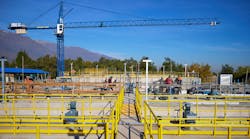Delta Cooling Towers developed an anti-microbial HDPE material that reduces Legionella and other strains of deadly pathogens. Its new line of towers is constructed of anti-microbial resin, which is fully compounded into the base cooling tower material.
The anti-microbial resin contains additives that operate on a cellular level to continuously disrupt and prevent uncontrolled growth of microorganisms and biofilm within the cooling tower. Efficacy tests were performed by Special Pathogens Laboratory, the Legionella Experts.
According to the Centers for Disease Control and Prevention, in many cases, Legionella is incubated and spread through water systems. Under certain common conditions, cooling towers can propagate Legionella. This has recently led ANSI/ASHRAE to publish its Standard 188, Legionellosis: Risk Management for Building Water Systems, which documents new risk standards and requirements for engineers that design new buildings and renovations to existing structures.
“Without consistent competent water treatment, the Legionella risk is not completely eliminated, even with the new antimicrobial cooling tower,” said John Flaherty, president of Delta. “While cooling tower conditions are often managed by water treatment chemicals, such treatment is sometimes inadequate, and poor piping designs lead to ‘dead legs,’ creating an environment in which pathogens, including Legionella, can thrive.”
According to Delta, the best water treatments for Legionella prevention are oxidizing biocides, which react aggressively toward metal surfaces, effectively attacking metal-clad cooling towers and shortening service life. However, because Delta’s cooling tower fills and shells are constructed of anti-microbial plastic, they are virtually impervious to corrosive water treatments and minimize the risk of microbial growth. Delta’s cooling tower designs also feature a sloped basin and/or basin sweeper system to avoid creating stagnant water, where Legionella can grow.
Source: Delta Cooling Towers


